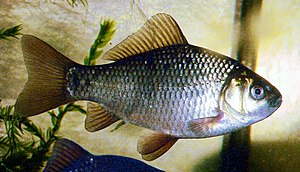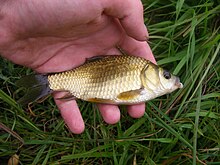Crucian carp
| Crucian carp | ||||||||||||
|---|---|---|---|---|---|---|---|---|---|---|---|---|

Crucian carp ( Carassius carassius ) |
||||||||||||
| Systematics | ||||||||||||
|
||||||||||||
| Scientific name | ||||||||||||
| Carassius carassius | ||||||||||||
| ( Linnaeus , 1758) |
The crucian carp ( Carassius carassius ) is a species of fish from the carp family (Cyprinidae). It is closely related to the gable , the stem shape of the goldfish . Other names are: tailor carp, farmer carp, stone carp, moor carp, Gareisle, Guratsch, Burretschel and Kotbuckel.
distribution
The crucian carp lives almost all over Europe with the exception of Ireland , Scotland and Wales , much of the Iberian Peninsula and western France . The populations in Spain are due to human occupation. In Italy the crucian carp is found only in the Po area, in Denmark only on the Jutland peninsula . It is also absent in the Maritime Alps and the Upper Rhine . It is absent in large parts of Greece in the Balkans , as well as in the areas bordering the Adriatic Sea . In the areas bordering the Marmara Sea , it is also represented in Asia Minor . European Russia inhabits them up to the Urals and reaches northwest Asia with the lower Ob river . The Romanian ichthyologist Petre Mihai Bănărescu believed that crucian carp are native to Central and Eastern Europe, while other fisheries biologists believe that they were imported from China.
features
The crucian carp is similar to the carp , but higher-backed - a similarity that is also expressed in the above-mentioned nicknames such as tailor carp, farm carp, stone carp or bog carp. She has no barbels and large scales. Their upper side is brownish with a greenish sheen, the flanks are lighter, the underside light, yellowish to dirty white. The caudal fin is only slightly notched. Crucian carp are slow-growing, can be up to 64 centimeters long and weigh 3 kilograms.
Fin formula: dorsal 3–4 / 14–21, anal 3 / 5–8, pectoral 1 / 12–13, ventral 2–3 / 7–8
Way of life
The crucian carp prefers flat, heavily overgrown lakes, ponds and ponds and avoids cold, fast-flowing waters. It can be found even in the smallest of oxygen-poor, muddy village ponds. Crucians can survive for five days with almost no oxygen. Crucian carp can often form small populations under extreme conditions such as in acidic moor waters with a low oxygen content and very little food supply. The alcohol content in the blood of crucian carp even enables them to survive a complete freezing of water. The great resilience of the crucian carp has meant that it has achieved a certain importance as an experimental fish. Low stunted forms can develop into normal high backed forms as living conditions improve. In Eastern Europe they are of greater local importance, especially in waters where they are only one of a few existing species.
Crucian carp feed on small animals such as the larvae of midges and mayflies , and plants. In order to survive periods without access to food, crucian carp store sugar in the form of glycogen in the liver and muscle tissue.
The spawning season is May and June. The female lays around 150,000 to 300,000 eggs, 1–1.5 millimeters in size, which stick to aquatic plants. Depending on the water temperature, the larvae hatch after three to seven days. After three to four years they become sexually mature with a length of about 8 to 15 centimeters.
Hazardous situation
The International Union for Conservation of Nature ( IUCN) classifies the crucian carp in the Red List of Endangered Species as “ Least Concern ” . However, a gradual and sustained decline in stocks has been observed in individual bodies of water, especially in the Danube river system and in Central Europe in general. The reason for this could be competitive pressure from the introduced gable or silver crucian carp (Carassius gibelio). In Germany the crucian carp is on the red list of endangered species in category 2: endangered. The loss and degradation of plant-rich ponds, especially through agriculture, is held responsible as a source of danger. In Lower Saxony, therefore, sport fishermen and recreational anglers try to spread the crucian carp again through targeted stocking. The crucian owes its place on the red list to the ongoing destruction or lasting changes to its habitats, which are also threatened: small ponds and standing waters, oxbow lakes and floodplains, types of water that have been increasingly created or renatured by fishing clubs in Lower Saxony in recent years. In such small bodies of water, the released fish can now spawn and multiply on their own again.
The Association of German Sport Fishermen , which named them Fish of the Year 2010, points out that their stocks are declining due to the destruction of natural habitats in Germany and Austria .
Fishing for crucian carp
General
In 2004 a 3.5 kg crucian was caught in Pichlinger See near Linz in Austria with a vanilla boilie as bait. Large crucian carp are also reported from the River Niers, the Poelvennsee near the Dutch border. The "crucian carp from Westerdeichstrich" became famous near Büsum , where they are caught in large weights. In Eastern Europe and Russia, crucians reach the largest final weights, in Russia even up to 5 kg.
Crucian carp are very careful fish that can be fished with fine to ultra-fine float fishing rods. Baits are compost worms , maggots, maize and dough with the siphon / lift method (float float, when bitten, the float lifts out of the water) and attached leader so as not to scare off shy animals with moving bait. Since crucian carp have a very small mouth, hook size 12 should not be exceeded. Good crucian carp waters are shallow, muddy and heavily weed stagnant waters, where schools of crucian carp are often found at the bottom of flat reed or herb edges as well as water lily fields. The best catches are made in the warmer months of the year from May to September, with large specimens usually being caught at dawn or dusk.
Crucian carp are ecologically very adaptable, you can find them in small, shallow, heavily weedy and muddy ponds that warm up strongly in summer, in bog pools, peat cuttings, isolated forest lakes, village ponds but also in park ponds and large lakes, where there are separate, quiet bays extensive water lily fields can offer the crucians ideal living conditions. In small waters where carp and tench are the only fish species verbutten stocks frequently, making it the diminutive type of "plate or Steinkarausche". Only when pike are also found in the crucian carp habitat can healthy populations develop, as the predatory fish reduce the competition for food between the crucian carp and regulate the population. In uniform, shallow standing waters, schools of crucians often roam around in the company of carp of the same age in search of food. The crucian carp's natural diet is mosquito and caddis fly larvae, small snails and mussels. Large crucian carp are often nocturnal.
Fishing bans
According to the state fishing regulations of the German federal states of Hesse (§ 1) and Rhineland-Palatinate (§ 20/2), fishing for crucian carp is not allowed there.
literature
- Uwe Hartmann: Steinbach's nature guide, freshwater fish. Ulmer Verlag, Stuttgart 2003, ISBN 3-8001-4296-1
- Günther Sterba : Freshwater fish in the world . Weltbild Verlag, Augsburg 2002, ISBN 3-89350-991-7
- Bănărescu, Petru (1961): Some questions about the origin and distribution of the freshwater fish fauna of the European-Mediterranean sub-region. In: Archives for Hydrobiology. 57, pp. 57, 73, 76, 85
- Bănărescu, Petru: Fauna Republicii Populare Romîne, Pisces-Osteichthyes. (from it: Umbridae) Bucharest 1964, pp. 285–291
- Bănărescu, Petru (1961): Animal-geographical considerations on the fish fauna of the Danube basin. Rat. Internat. Society. Limnologie 14, pp. 386-389
- Wüstemann, Otfried: The crucian carp - fish of the year 2010 ; in: Our Harz - magazine for local history, customs and nature, 8/2010, pp. 170–171
Individual evidence
- ↑ Günther Sterba: Freshwater fish of the world . Weltbild Verlag, Augsburg 2002, ISBN 3-89350-991-7 .
- ↑ World champion in holding your breath: the crucian carp. On: Wissenschaft.de of October 1, 2004. The fish can survive for several days almost without oxygen ( Science Vol. 306, p. 77, 2005).
- ^ Wüstemann, Otfried: The crucian carp - fish of the year 2010 ; in: Our Harz - magazine for local history, customs and nature, 8/2010, pp. 170–171
- ↑ a b Carassius carassius in the endangered Red List species the IUCN 2009. Posted by: Freyhof, J. & Kottelat, M., 2008. Accessed March 7 of 2010.
- ↑ Jörg Freyhof: Red list of the lampreys and fish reproducing in freshwater (Cyclostomata & Pisces), fifth version. Conservation and Biodiversity 70 (1): 291–316.
- ↑ "Species protection project crucian carp successfully continued" Press release of the German Fishing Association of October 13, 2014 ( Memento of July 5, 2015 in the Internet Archive )
- ^ Association of German Sport Fishermen (VDSF) ( Memento from February 28, 2010 in the Internet Archive ) on crucian carp
Web links
- Crucian carp on Fishbase.org (English)





